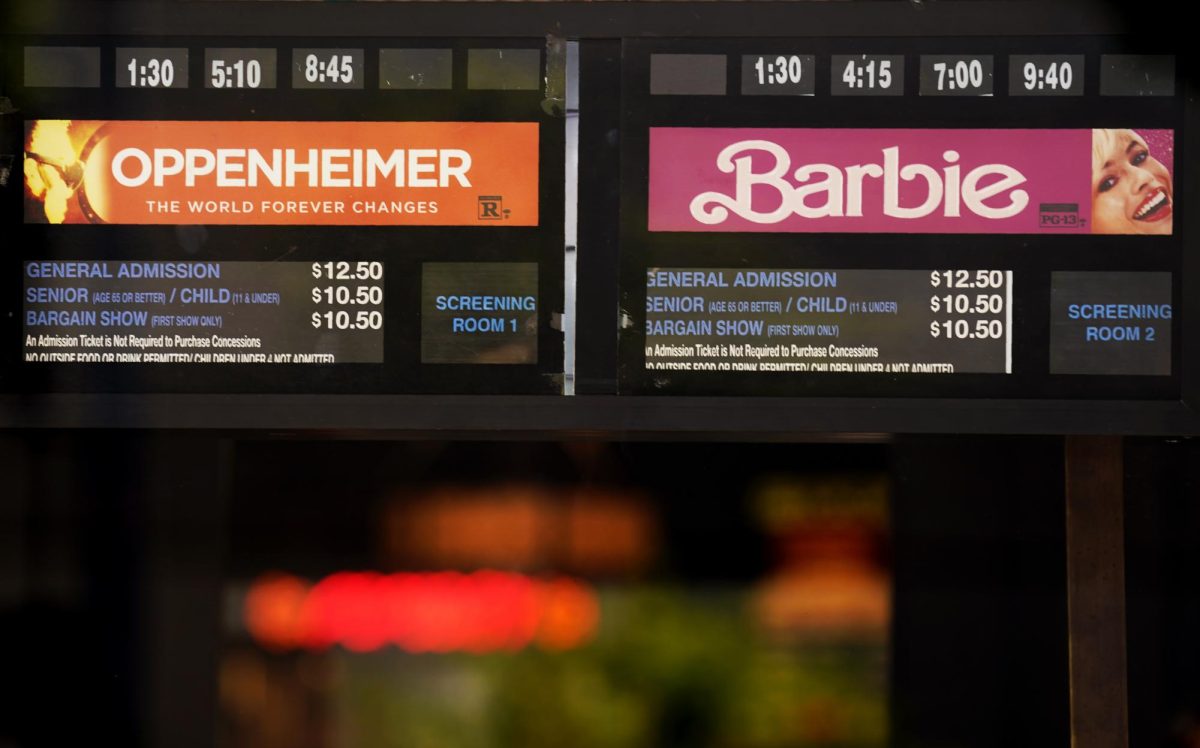Physics, fedoras and brooding. Hot pink, pop songs and dance numbers. These two radically different worlds collided in cinema and pop culture this past summer.
Most Pitt students have likely heard a thing or two about the pairing of Greta Gerwig’s “Barbie”
with Christopher Nolan’s “Oppenheimer.” The polar-opposite aesthetic creation “Barbenheimer” took two summer feature films and turned them into a successful pop culture behemoth that is part meme, part trend and all parts marketing strategy.
Sarah Dugan, an undeclared first-year, worked at the South Hills AMC over the summer and experienced the Barbenheimer craze firsthand.
“Usually it’s a new movie, opening weekend, people will come in — but everyone kept coming,” Dugan said. “It was probably such a big event because it was at the movie theaters again. It was a nostalgic thing for people to do.”
Ellie Kannel, an undeclared first-year, said Barbenheimer’s juxtaposition of aesthetics made for an exciting experience.
“I’m pro-the relationship between the two movies,” Kannel said. “There were cool press pictures of Margot Robbie and Greta Gerwig going to see “Oppenheimer,” and then Cillian Murphy seeing ‘Barbie.’ If it helped market for both movies, then there’s definitely no harm.”
Savvy marketing contributed to undeclared first-year Ishanvi Bachwal’s appreciation for Barbenheimer.
“The marketing was genius — bright pink and then just pitch black,” Bachwal said. “It was nice when you went to the theater, all the posters were outside and you know, it was just, ‘cinema is back.’”
For Saanvi Puchakatla, the “Barbenheimer” trend of marathoning the two films –– complete with a costume change from hot pink to 1940’s wartime apparel (or vice-versa, depending on the order) –– brought her to the theater.
“I just thought it would be fun to follow the trend,” Puchakatla, an undeclared first-year, said. “I saw people on TikTok going in pink dresses for ‘Barbie’ and then going to the bathroom at the movies and switching to suits for [Oppenheimer]. I thought it was funny, so me and my friends did it too.”
What stuck with Puchakatla after the Barbenheimer experience is what stuck with a lot of Pitt students following the features, even if it’s not what they expected — the empowering feminist themes of “Barbie.”
“‘Barbie’ was so different from what I expected to be,” Puchakatla said. “I was expecting something like cartoons, but it had a really good message.”
Kannel found herself in a similar spot to Puchakatla after seeing “Barbie.”
“I knew nothing about it, going in. I thought it was going to be a ‘fun’ movie about Barbie, and then I saw it and sobbed,” Kannel said.
While the cultural storm of “Barbie” touched many Pitt students on an emotional level, its lessons about toxic masculinity also led some male students to examine their expressions of gender.
Dillon Lanier, an undeclared first-year, has spent his second week of college strutting the quad in hot pink shorts, a color choice he said is purposeful.
“A girl said that my house was like a ‘mojo-dojo’ house –– which is not good,” Lanier said. “I had to ‘Barbify’ my house and my life.”
Although Pitt students expressed interest in how the pink pop culture dream world of “Barbie” highlighted the masculine darkness of “Oppenheimer” through the double feature’s contrast, some students felt that “Oppenheimer” was emblematic of the toxic masculinity that “Barbie” itself called attention to.
Malik Yasin, a junior psychology major who grew up in a family with physicists from a war-torn country, said “Oppenheimer” came across as a disappointing romanticization of J. Robert Oppenheimer’s role in developing the atomic bomb.
“‘Oppenheimer’ seemed like they were trying to romanticize the idea of the atomic bomb, something so horrendous that shouldn’t be seen in that way,” Yasin said. “It’s romantic in that way, but not in a good way. It seems very, ‘this is what masculinity is like. This is what it means to be a tortured man. This is what is aesthetic for men.’ I think that’s a very dangerous ideology as well.”
“Barbie,” “Oppenheimer” and their mega-marketing pop culture meme baby “Barbenheimer” generated a hype that brought Pitt students to the theater, something Yasin encourages others to continue.
“Go watch some movies! Like, genuinely, just go out there and support your local cinemas,.” Yasin said.
Lanier posed a hypothetical question.
“Ken son, or Oppenheimer daughter?” Lanier asked. “Well, let’s see. Oppenheimer killed hundreds of thousands.”
Lanier paused and broke into Ryan Gosling’s song “Push” from “Barbie.”
“I’d probably pick a Ken son,” Lanier said.


